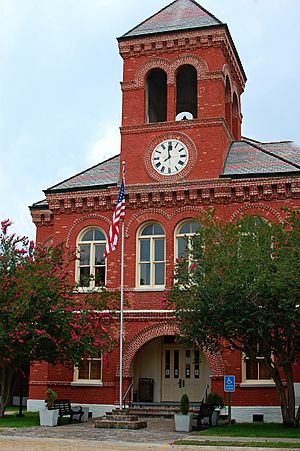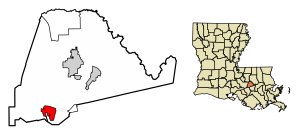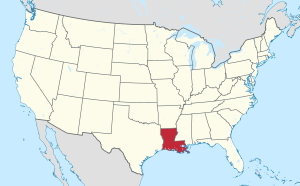Donaldsonville, Louisiana facts for kids
Quick facts for kids
Donaldsonville, Louisiana
|
|
|---|---|

The Old Ascension Parish Courthouse is located on Railroad Avenue in Donaldsonville
|
|

Location of Donaldsonville in Ascension Parish, Louisiana.
|
|

Location of Louisiana in the United States
|
|
| Country | United States |
| State | Louisiana |
| Parish | Ascension |
| Area | |
| • Total | 3.80 sq mi (9.84 km2) |
| • Land | 3.78 sq mi (9.78 km2) |
| • Water | 0.02 sq mi (0.06 km2) |
| Elevation | 26 ft (8 m) |
| Population
(2020)
|
|
| • Total | 6,695 |
| • Density | 1,772.10/sq mi (684.23/km2) |
| Time zone | UTC-6 (CST) |
| • Summer (DST) | UTC-5 (CDT) |
| ZIP Code |
70346
|
| Area code(s) | 225 |
| FIPS code | 22-21240 |
| Website | http://www.donaldsonville-la.gov/ |
Donaldsonville is a city in Louisiana, USA. It's the main town of Ascension Parish and sits on the west bank of the Mississippi River. It's part of the larger Baton Rouge area. In 2020, about 6,695 people lived there.
The historic part of Donaldsonville has many beautiful old buildings. These buildings show what the town looked like from before the American Civil War up to 1933. During the Civil War, Union soldiers attacked and took over the city in 1862. They built a fort called Fort Butler by the Mississippi River. In 1863, this fort was successfully defended against an attack by Confederate forces. This battle was important because it was one of the first times that free African Americans and formerly enslaved people fought as soldiers for the Union. Fort Butler is now a recognized historic place.
After the Civil War, in 1868, the people of Donaldsonville elected Pierre Caliste Landry as their mayor. He was an attorney and a minister. He was also the first African American to be elected mayor in the United States.
Contents
Discovering Donaldsonville's Past
The French were the first Europeans to settle this area. They called it Lafourche-des-Chitimachas. This name came from the local Native American people, the Chitimachas, and the nearby bayou. The French started large sugar cane farms here. These farms used the labor of enslaved people from Africa.
Later, in the mid-1700s, Acadians (French-speaking people from Canada) moved to the area. They had been forced out of their homes by the British. They started small farms to grow food for themselves. Spanish settlers also came to live here. In 1772, when Spain controlled the area, a church was built called the Ascension of Our Lord Catholic Church.
In 1803, the United States bought this land as part of the Louisiana Purchase. More Americans began to move in. In 1806, a wealthy landowner named William Donaldson hired an architect to plan a new town. The town was then named Donaldsonville after him.
From 1829 to 1831, Donaldsonville was the capital of Louisiana. This happened because English-speaking Americans wanted the capital moved away from New Orleans. They thought New Orleans was too noisy. French-speaking Creoles, however, wanted the capital to stay in a French-speaking area. So, Donaldsonville became a compromise.
During the years before the Civil War, many wealthy plantation owners built beautiful homes and other buildings in Donaldsonville. They made their money from growing sugar and cotton.
Donaldsonville During the Civil War
In the summer of 1862, during the American Civil War, Donaldsonville was attacked by Union forces. This was part of their plan to control the Mississippi River. Union ships warned that if anyone fired at them, they would destroy buildings for miles around.
Admiral David G. Farragut of the Union Navy destroyed much of the city. He also put the area under military rule. A local historian described how people left their homes as Union soldiers set fire to buildings. Plantations were also attacked and burned.
Some citizens complained that the Confederate soldiers in the area were not protecting them. They felt unsafe and that their property was being stolen.
The Union forces set up a base in Donaldsonville. They took over some plantations to grow crops and supply their soldiers.
Building and Defending Fort Butler
Many enslaved people escaped and came to the Union lines in Donaldsonville. General Benjamin Butler said they were "contrabands of war." This meant they would not be returned to their enslavers. These freed people stayed and helped the Union soldiers. They helped build Fort Butler, a star-shaped fort in the town.
The fort was made of earth and wood. It was built to hold 600 soldiers. But in 1863, only about 180 Union soldiers were there. These soldiers included the 1st Louisiana Volunteers, some sick soldiers from the Louisiana Native Guard, and some formerly enslaved people.
In June 1863, over 1,000 Confederate soldiers, led by General Tom Green, attacked Fort Butler at night. But the Union soldiers, including free African Americans and formerly enslaved people, fought bravely. They successfully defended the fort. This was one of the first times that African Americans fought as soldiers for the Union. A newspaper at the time said that the African American soldiers were "stimulated to daring deeds." A historian later wrote that "Not only did black hands build this citadel of freedom, they defended it to the death." The Union kept control of the fort. Today, Fort Butler is a recognized historic place.
Donaldsonville After the War
After the Civil War, Donaldsonville became one of the largest African American communities in Louisiana. Many freed people moved there for safety and new opportunities. In 1868, Pierre Caliste Landry, who had been enslaved, was elected mayor. He was the first African American mayor in the United States. He became a lawyer and a state politician.
Donaldsonville is also home to one of the oldest Jewish synagogues still standing in the United States. It was built in 1872. Today, the building is used as a hardware store. The Jewish Cemetery in town dates back to the 1800s.
In the early 1900s, many people left the area. This was partly because farming became more mechanized. Also, many African Americans moved to northern and midwestern cities for better jobs. This period was called the Great Migration. Donaldsonville and Ascension Parish lost many people and businesses during this time.
During the Great Depression, the town faced economic challenges. However, mayors Sidney A. Marchand and his son, Sidney Marchand, Jr., helped build important things in Donaldsonville. They added miles of paved roads and a sewer system that is still used today.
Today, Donaldsonville is a small city with many historic sites. Since 2008, the River Road African American Museum in the city has been part of the Louisiana African American Heritage Trail. The city also has parks, Civil War sites, and places to shop.
The local newspaper, the Donaldsonville Chief, has been published since 1871.
Donaldsonville's Location and Weather
Donaldsonville covers about 2.5 square miles (6.5 square kilometers) of land. It sits about 25 feet (7.6 meters) above sea level. The city is located where Bayou Lafourche used to branch off from the Mississippi River. The entrance to the bayou was dammed in 1905.
What's the Weather Like?
| Climate data for Donaldsonville, Louisiana (1991–2020 normals, extremes 1893–present) | |||||||||||||
|---|---|---|---|---|---|---|---|---|---|---|---|---|---|
| Month | Jan | Feb | Mar | Apr | May | Jun | Jul | Aug | Sep | Oct | Nov | Dec | Year |
| Record high °F (°C) | 92 (33) |
88 (31) |
94 (34) |
97 (36) |
100 (38) |
102 (39) |
102 (39) |
105 (41) |
103 (39) |
100 (38) |
92 (33) |
90 (32) |
104 (40) |
| Mean maximum °F (°C) | 77.4 (25.2) |
79.6 (26.4) |
83.5 (28.6) |
86.7 (30.4) |
91.2 (32.9) |
94.2 (34.6) |
95.4 (35.2) |
95.9 (35.5) |
93.8 (34.3) |
89.5 (31.9) |
83.4 (28.6) |
79.7 (26.5) |
96.7 (35.9) |
| Mean daily maximum °F (°C) | 62.1 (16.7) |
66.1 (18.9) |
72.4 (22.4) |
78.4 (25.8) |
84.9 (29.4) |
89.2 (31.8) |
90.6 (32.6) |
90.8 (32.7) |
87.6 (30.9) |
80.3 (26.8) |
70.9 (21.6) |
64.4 (18.0) |
78.1 (25.6) |
| Daily mean °F (°C) | 51.9 (11.1) |
55.6 (13.1) |
61.7 (16.5) |
67.8 (19.9) |
75.0 (23.9) |
80.4 (26.9) |
82.1 (27.8) |
81.9 (27.7) |
78.3 (25.7) |
69.4 (20.8) |
59.8 (15.4) |
54.1 (12.3) |
68.2 (20.1) |
| Mean daily minimum °F (°C) | 41.7 (5.4) |
45.2 (7.3) |
51.0 (10.6) |
57.1 (13.9) |
65.1 (18.4) |
71.6 (22.0) |
73.5 (23.1) |
73.1 (22.8) |
69.1 (20.6) |
58.6 (14.8) |
48.6 (9.2) |
43.7 (6.5) |
58.2 (14.6) |
| Mean minimum °F (°C) | 25.6 (−3.6) |
30.4 (−0.9) |
34.1 (1.2) |
42.1 (5.6) |
53.4 (11.9) |
64.8 (18.2) |
69.0 (20.6) |
68.4 (20.2) |
57.9 (14.4) |
42.4 (5.8) |
33.5 (0.8) |
29.1 (−1.6) |
24.3 (−4.3) |
| Record low °F (°C) | 10 (−12) |
3 (−16) |
24 (−4) |
32 (0) |
41 (5) |
54 (12) |
59 (15) |
60 (16) |
43 (6) |
26 (−3) |
21 (−6) |
9 (−13) |
3 (−16) |
| Average precipitation inches (mm) | 5.78 (147) |
4.11 (104) |
4.03 (102) |
4.88 (124) |
5.64 (143) |
6.97 (177) |
6.51 (165) |
6.37 (162) |
5.39 (137) |
4.65 (118) |
4.21 (107) |
4.86 (123) |
63.40 (1,610) |
| Average snowfall inches (cm) | 0.0 (0.0) |
0.0 (0.0) |
0.0 (0.0) |
0.0 (0.0) |
0.0 (0.0) |
0.0 (0.0) |
0.0 (0.0) |
0.0 (0.0) |
0.0 (0.0) |
0.0 (0.0) |
0.0 (0.0) |
0.1 (0.25) |
0.1 (0.25) |
| Average precipitation days (≥ 0.01 in) | 10.6 | 8.9 | 8.0 | 7.4 | 8.0 | 12.3 | 13.4 | 12.9 | 8.9 | 6.7 | 7.3 | 9.0 | 113.4 |
| Average snowy days (≥ 0.1 in) | 0.0 | 0.0 | 0.0 | 0.0 | 0.0 | 0.0 | 0.0 | 0.0 | 0.0 | 0.0 | 0.0 | 0.2 | 0.2 |
| Source: NOAA | |||||||||||||
Who Lives in Donaldsonville?
| Historical population | |||
|---|---|---|---|
| Census | Pop. | %± | |
| 1860 | 1,475 | — | |
| 1870 | 1,573 | 6.6% | |
| 1880 | 2,600 | 65.3% | |
| 1890 | 3,121 | 20.0% | |
| 1900 | 4,105 | 31.5% | |
| 1910 | 4,090 | −0.4% | |
| 1920 | 3,745 | −8.4% | |
| 1930 | 3,788 | 1.1% | |
| 1940 | 3,889 | 2.7% | |
| 1950 | 4,150 | 6.7% | |
| 1960 | 6,082 | 46.6% | |
| 1970 | 7,367 | 21.1% | |
| 1980 | 7,901 | 7.2% | |
| 1990 | 7,949 | 0.6% | |
| 2000 | 7,605 | −4.3% | |
| 2010 | 7,436 | −2.2% | |
| 2020 | 6,695 | −10.0% | |
| U.S. Decennial Census | |||
| Race | Number | Percentage |
|---|---|---|
| White (non-Hispanic) | 1,208 | 18.04% |
| Black or African American (non-Hispanic) | 5,176 | 77.31% |
| Native American | 1 | 0.01% |
| Asian | 13 | 0.19% |
| Other/Mixed | 136 | 2.03% |
| Hispanic or Latino | 161 | 2.4% |
In 2020, the U.S. Census Bureau reported that 6,695 people lived in Donaldsonville. This was a decrease from 7,436 people in 2010.
The city's population in 2020 was mostly African American (77.31%). About 18.04% of the people were non-Hispanic white. Other groups included Native American, Asian, and people of two or more races. About 2.4% of the population was Hispanic or Latino.
In 2000, the average income for a household in Donaldsonville was $24,084. For families, it was $29,408. By 2019, the average household income had risen to $25,551, and for families, it was $36,667.
Famous People from Donaldsonville
Many notable people have come from Donaldsonville:
- Bernette Joshua Johnson (born 1943) – She was the Chief Justice of the Louisiana Supreme Court from 2013 to 2020.
- D-D Breaux – A well-known coach for the LSU Lady Tigers gymnastics team.
- Jarvis Green – A defensive end who played for the New England Patriots in the NFL.
- Howard Green – Another defensive end who played in the NFL.
- Jack P. F. Gremillion (1914–2001) – He was the Attorney General of Louisiana from 1956 to 1972.
- Henry Johnson – Served as the Governor of Louisiana from 1824 to 1828.
- Plas Johnson – A famous saxophonist.
- Duncan F. Kenner (1813–1887) – He built Ashland Plantation and was an ambassador for the Confederate States during the Civil War. He also founded the city of Kenner.
- Joseph Aristide Landry (1817–1881) – A Congressman.
- Pierre Caliste Landry – The first African-American mayor in the US, elected in 1868.
- John Harvey Lowery (1860–1941) – A doctor and generous giver to charity.
- Francis T. Nicholls – Served as Governor of Louisiana twice (1877–80, 1888–92) and was a Confederate general.
- King Oliver (1881–1938) – A very important jazz musician.
- Stephen Sullivan – An NFL tight end for the Carolina Panthers.
- Nicholas Trist – He helped negotiate the Treaty of Guadalupe-Hidalgo.
- Sarah S. Vance – A judge for the U.S. District Court in Louisiana.
- Edward Douglass White, Sr. – Governor of Louisiana (1834–38) and father of a future US Chief Justice.
- Claiborne Williams (1868–1952) – A famous bandleader.
See also
 In Spanish: Donaldsonville para niños
In Spanish: Donaldsonville para niños




